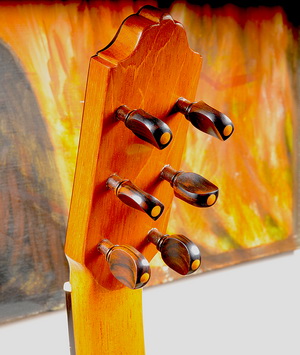Guitar Pegs
As the word "pegs" is a multi-use term regarding a guitar, there are several commonly associated parts of the guitar that are referred to as guitar pegs. One such piece is the bridge nut: the usually plastic piece that holds the strings in place at the top of the neck, closest to the headstock, (where the next set of guitar pegs are found). On the headstock, there are tuning adjustment pegs called "machineheads" or "heads". Another commonly associated peg on the guitar is strap peg that's found at the base of the body of the guitar. Depending on what kind of guitar pegs you need, you'll want to invest in one or all of these guitar parts.
Guitar Bridge Pegs
Bridge pegs are often plastic but can be an assortment of different materials including poly-carbon and ceramic. They are usually glued into place at the top of the neck within a notch cut out to fit the bridge’s width and length. The height of the bridge varies depending on string overlay. Left-handed guitarists can learn to play classically (low E is string 1, A is string 2, D is string 3, etc.) as opposed to left-handed flip, (made famous by guitarists such as Jimi Hendrix and Eric Clapton) where the high E string is in string 1 position. It is as easy as replacing a bridge nut on a right-handed guitar in flipped position. You’ll see that there are recesses in the nut where strings are to overlay: ensure that the largest recess for the low E string is aligned to be position 1 string when playing naturally. Epoxy your new nut in after clearing all excess glue out with a small chisel.
Tuning Pegs, AKA: Machineheads
Often guitar pegs are direct references to tuning pegs, or machineheads, (aka: machine heads, guitar heads, “heads”, tuners, etc.). These are crucial parts of the guitar as an instrument because they allow tuning of individual strings. Without the strings of an instrument being in tune, the instrument is unplayable. Good machineheads will have large diameters yielding a great difference in tone with a single rotation. They will apply consistent yet non-abrasive tension to the string and maintain the pitch you tune to before practice or performance. A bad machinehead can mean horrible sounding notes within ten to twenty minutes of playing.
Fret Bars, Inlays and More
Fret bars are metal and they’re usually quite well fixed into a guitar. If by chance you damage one and want to replace it, beware that the process isn’t as simple as a bridge nut replacement. Guitar inlays are also the kind of thing you’ll want a professional to take care of rather than trying it on your own. Decals on electrics and custom knobs are all available and are simple to install. Typically you can find guitar pegs and supplies at any of the following online stores:
- J & R Music and Computers
- Sam Ash
- Musicians Friend
- Guitar Center
- George’s Music
- Yamaha
- Gibson
- Fender
- Schaller
- Sperzel

